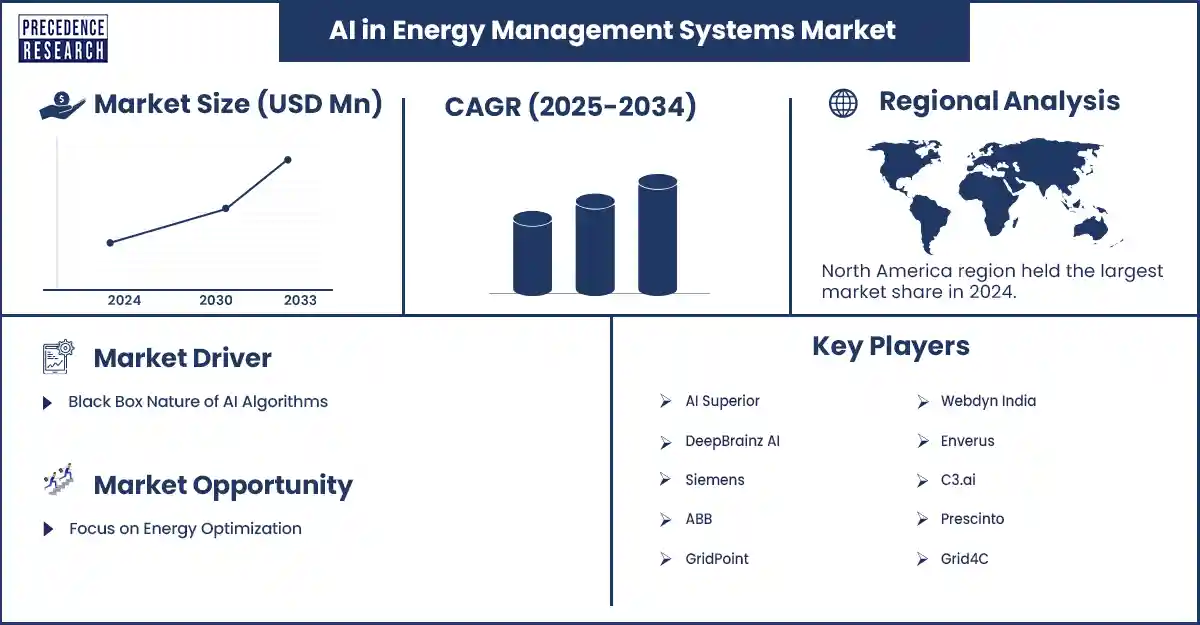AI in Energy Management Systems Market Revenue and Forecast by 2033
AI in Energy Management Systems Market Revenue and Trends 2025 to 2033
The global AI in energy management systems market is projected to grow robustly as smart platforms optimize consumption, integrate renewables, and reduce operational costs. The market growth is driven by the increasing adoption of AI across the energy value chain, as organizations seek to optimize energy consumption, enhance system reliability, and achieve sustainability goals.

What are the major factors driving the growth of the AI in energy management systems market?
Several factors are driving the growth of the market for AI in energy management systems. Energy system operators are under increasing pressure to enhance energy efficiency and reduce greenhouse gas emissions, prompting utility companies and large customers to adopt AI-based systems that identify inefficiencies and optimize energy use in real-time. The expansion of distributed energy resources (DERs), such as rooftop solar, batteries, and demand response, complicates the balancing of supply and demand, thereby increasing the need for intelligent orchestration that AI can provide.
Furthermore, advancements in machine learning (ML), edge computing, and IoT sensor networks have reduced the entry-level costs for energy AI systems, making deployment more accessible. Governmental incentives and unique revenue streams actively encourage investment in smart energy systems, while stated climate goals and carbon pricing further stimulate investment and expand the market for AI capabilities. Finally, the ongoing digitalization of assets and data infrastructures within utilities and enterprises provides the essential data infrastructure that allows AI models to learn, adapt, and generate valuable insights.
Segment Insights
- By application, the energy consumption optimization segment dominated the market in 2024 because it helps organizations reduce waste and increase operational efficiency.
- By end-user industry, the utilities segment dominated the market with the largest share in 2024, as grid operators and energy dealers heavily rely on AI for load balancing, outage prediction, and network optimization.
- By deployment mode, the cloud-based solutions segment led the market in 2024 due to their scalability, lower upfront costs, and ease of model updates.
- By component, the software segment dominated the market with a major revenue share in 2024, as it consolidates vital functionalities such as analytics, forecasting, and optimization essential for AI processes.
Regional Insights
North America dominated the AI in energy management systems market in 2024, driven by several key factors. Robust research and development ecosystems, coupled with substantial investments in smart grid modernization, created a favorable environment for innovation. Supportive regulatory frameworks in the U.S. and Canada encouraged early adoption and deployment of AI solutions. This, combined with strong funding and venture capital, cemented North America's leadership in the market.
Asia Pacific is expected to experience rapid growth in the coming years due to a surge in electrification programs, urbanization, and renewable energy investments across countries like China, India, and Southeast Asia. Government mandates promoting energy transition and grid modernization through AI are prevalent. The expanding development of distributed energy systems in emerging markets further fuels AI development in the region.
AI in Energy Management Systems Market Coverage
| Report Attribute | Key Statistics |
| Quantitative Units | Revenue in USD million/billion, Volume in units |
| Largest Market | North America |
| Base Year | 2024 |
| Regions Covered | North America, Europe, Asia-Pacific, Latin America, and the Middle East & Africa |
Recent Development
- On October 9, 2025, Toshiba JSW Power Systems signed a contract with NTPC Limited to provide a centralized AI-powered monitoring system for 165 thermal and renewable power plants, enhancing operational efficiency and ensuring stable power supply starting spring 2027. The system integrates Toshiba’s EtaPRO™ software to enable real-time anomaly detection, root cause analysis, and automated maintenance, reducing plant shutdowns and improving reliability amid India’s expanding power capacity. (Source- https://www.global.toshiba)
Get this report to explore global market size, share, CAGR, and trends, featuring detailed segmental analysis and an insightful competitive landscape overview @ https://www.precedenceresearch.com/sample/6993
You can place an order or ask any questions, please feel free to contact us at sales@precedenceresearch.com |+1 804 441 9344